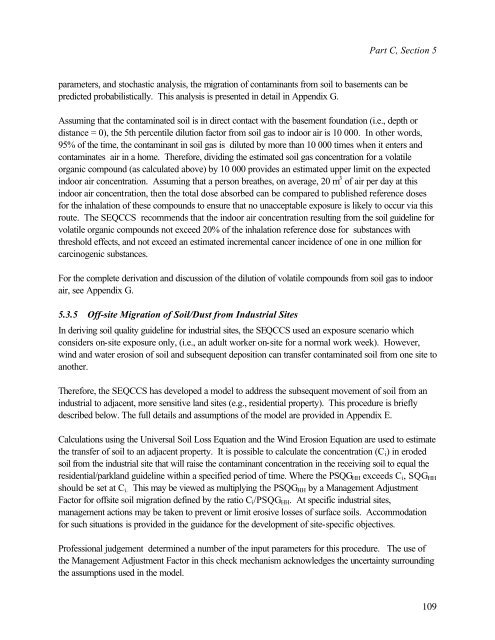Protocol for the Derivation of Environmental and Human ... - CCME
Protocol for the Derivation of Environmental and Human ... - CCME
Protocol for the Derivation of Environmental and Human ... - CCME
You also want an ePaper? Increase the reach of your titles
YUMPU automatically turns print PDFs into web optimized ePapers that Google loves.
Part C, Section 5<br />
parameters, <strong>and</strong> stochastic analysis, <strong>the</strong> migration <strong>of</strong> contaminants from soil to basements can be<br />
predicted probabilistically. This analysis is presented in detail in Appendix G.<br />
Assuming that <strong>the</strong> contaminated soil is in direct contact with <strong>the</strong> basement foundation (i.e., depth or<br />
distance = 0), <strong>the</strong> 5th percentile dilution factor from soil gas to indoor air is 10 000. In o<strong>the</strong>r words,<br />
95% <strong>of</strong> <strong>the</strong> time, <strong>the</strong> contaminant in soil gas is diluted by more than 10 000 times when it enters <strong>and</strong><br />
contaminates air in a home. There<strong>for</strong>e, dividing <strong>the</strong> estimated soil gas concentration <strong>for</strong> a volatile<br />
organic compound (as calculated above) by 10 000 provides an estimated upper limit on <strong>the</strong> expected<br />
indoor air concentration. Assuming that a person brea<strong>the</strong>s, on average, 20 m 3 <strong>of</strong> air per day at this<br />
indoor air concentration, <strong>the</strong>n <strong>the</strong> total dose absorbed can be compared to published reference doses<br />
<strong>for</strong> <strong>the</strong> inhalation <strong>of</strong> <strong>the</strong>se compounds to ensure that no unacceptable exposure is likely to occur via this<br />
route. The SEQCCS recommends that <strong>the</strong> indoor air concentration resulting from <strong>the</strong> soil guideline <strong>for</strong><br />
volatile organic compounds not exceed 20% <strong>of</strong> <strong>the</strong> inhalation reference dose <strong>for</strong> substances with<br />
threshold effects, <strong>and</strong> not exceed an estimated incremental cancer incidence <strong>of</strong> one in one million <strong>for</strong><br />
carcinogenic substances.<br />
For <strong>the</strong> complete derivation <strong>and</strong> discussion <strong>of</strong> <strong>the</strong> dilution <strong>of</strong> volatile compounds from soil gas to indoor<br />
air, see Appendix G.<br />
5.3.5 Off-site Migration <strong>of</strong> Soil/Dust from Industrial Sites<br />
In deriving soil quality guideline <strong>for</strong> industrial sites, <strong>the</strong> SEQCCS used an exposure scenario which<br />
considers on-site exposure only, (i.e., an adult worker on-site <strong>for</strong> a normal work week). However,<br />
wind <strong>and</strong> water erosion <strong>of</strong> soil <strong>and</strong> subsequent deposition can transfer contaminated soil from one site to<br />
ano<strong>the</strong>r.<br />
There<strong>for</strong>e, <strong>the</strong> SEQCCS has developed a model to address <strong>the</strong> subsequent movement <strong>of</strong> soil from an<br />
industrial to adjacent, more sensitive l<strong>and</strong> sites (e.g., residential property). This procedure is briefly<br />
described below. The full details <strong>and</strong> assumptions <strong>of</strong> <strong>the</strong> model are provided in Appendix E.<br />
Calculations using <strong>the</strong> Universal Soil Loss Equation <strong>and</strong> <strong>the</strong> Wind Erosion Equation are used to estimate<br />
<strong>the</strong> transfer <strong>of</strong> soil to an adjacent property. It is possible to calculate <strong>the</strong> concentration (C i ) in eroded<br />
soil from <strong>the</strong> industrial site that will raise <strong>the</strong> contaminant concentration in <strong>the</strong> receiving soil to equal <strong>the</strong><br />
residential/parkl<strong>and</strong> guideline within a specified period <strong>of</strong> time. Where <strong>the</strong> PSQG HH exceeds C i , SQG HH<br />
should be set at C i. This may be viewed as multiplying <strong>the</strong> PSQG HH by a Management Adjustment<br />
Factor <strong>for</strong> <strong>of</strong>fsite soil migration defined by <strong>the</strong> ratio C i /PSQG HH . At specific industrial sites,<br />
management actions may be taken to prevent or limit erosive losses <strong>of</strong> surface soils. Accommodation<br />
<strong>for</strong> such situations is provided in <strong>the</strong> guidance <strong>for</strong> <strong>the</strong> development <strong>of</strong> site-specific objectives.<br />
Pr<strong>of</strong>essional judgement determined a number <strong>of</strong> <strong>the</strong> input parameters <strong>for</strong> this procedure. The use <strong>of</strong><br />
<strong>the</strong> Management Adjustment Factor in this check mechanism acknowledges <strong>the</strong> uncertainty surrounding<br />
<strong>the</strong> assumptions used in <strong>the</strong> model.<br />
109
















